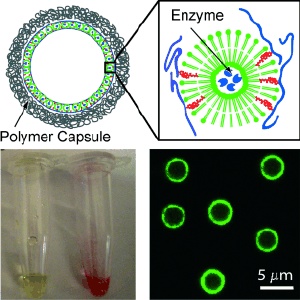May 19 2009
When cells cannot carry out the tasks required of them by our bodies, the result is disease. Nanobiotechnology researchers are looking for ways to allow synthetic systems take over simple cellular activities when they are absent from the cell. This requires transport systems that can encapsulate medications and other substances and release them in a controlled fashion at the right moment. The transporter must be able to interact with the surroundings in order to receive the signal to unload its cargo.
 © Wiley-VCH
© Wiley-VCH
A team led by Frank Caruso at the University of Melbourne has now developed a microcontainer that can hold thousands of individual "carrier units" - a "capsosome". As they report in the journal Angewandte Chemie, these are polymer capsules in which liposomes have been embedded to form subcompartments.
Currently, the primary type of nanotransporter used for drugs is the capsule: Polymer capsules form stable containers that are semipermeable, which allows for communication with the surrounding medium. However, these are not suitable for the transport of small molecules because they can escape. Liposomes are good at protecting small drug molecules; however, they are often unstable and impermeable to substances from the environment. The Australian researchers have now combined the advantages of both systems in their capsosomes.
Capsosomes are produced by several steps. First, a layer of polymer is deposited onto small silica spheres. This polymer contains building blocks modified with cholesterol. Liposomes that have been loaded with an enzyme can be securely anchored to the cholesterol units and thus attached to the polymer film. Subsequently, more polymer layers are added and then cross-linked by disulfide bridges into a gel by means of a specially developed, very gentle cross-linking reaction. In the final step, the silica core is etched away without damaging the sensitive cargo.
Experiments with an enzyme as model cargo demonstrated that the liposomes remain intact and the cargo does not escape. Addition of a detergent releases the enzyme in a functional state. By means of the enzymatic reaction, which causes a color change of the solution, it was possible to determine the number of liposome compartments to be about 8000 per polymer capsule.
“Because the capsosomes are biodegradable and nontoxic”, says Brigitte Staedler, a senior researcher in the group, “they would also be suitable for use as resorbable synthetic cell organelles and for the transport of drugs.” In addition, the scientists are planning to encapsulate liposomes filled with different enzymes together and to equip them with specific “receivers” which would allow the individual cargo to be released in a targeted fashion. This would make it possible to use enzymatic reaction cascades for catalytic reaction processes.